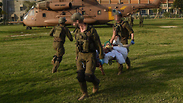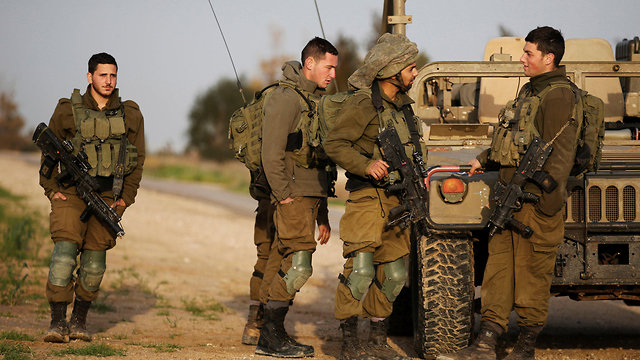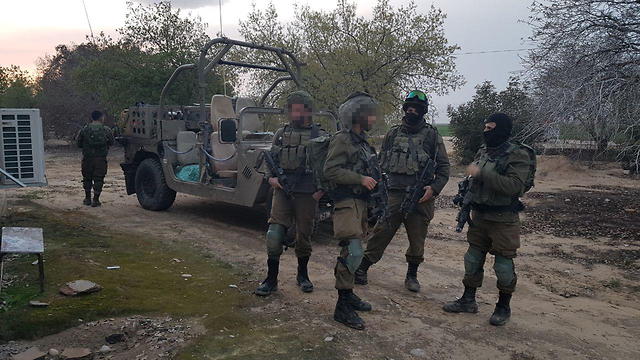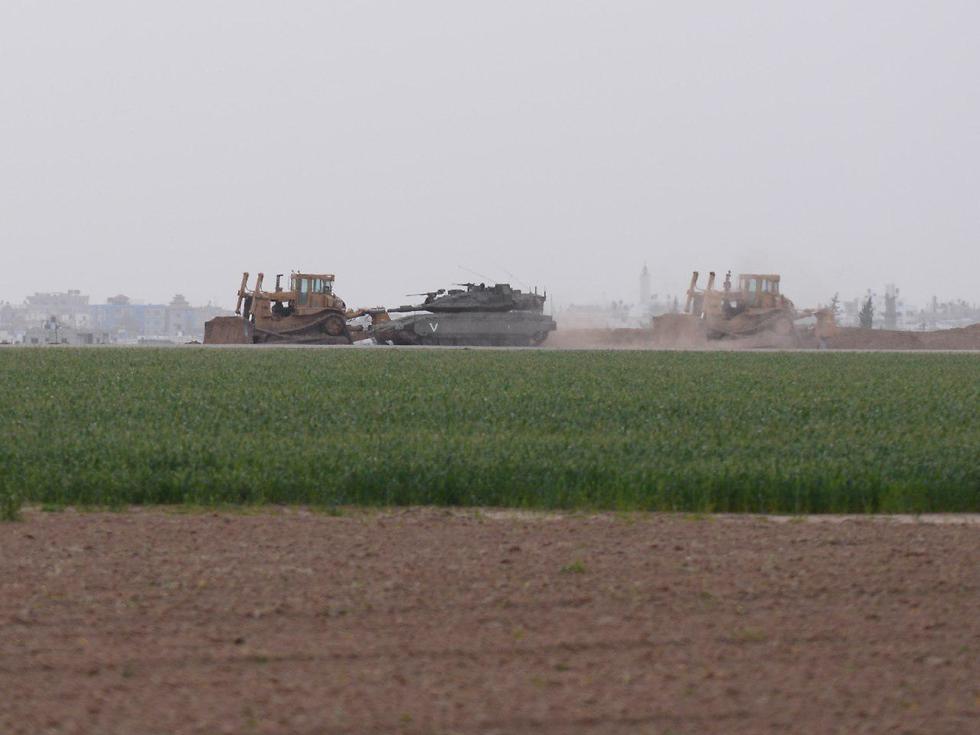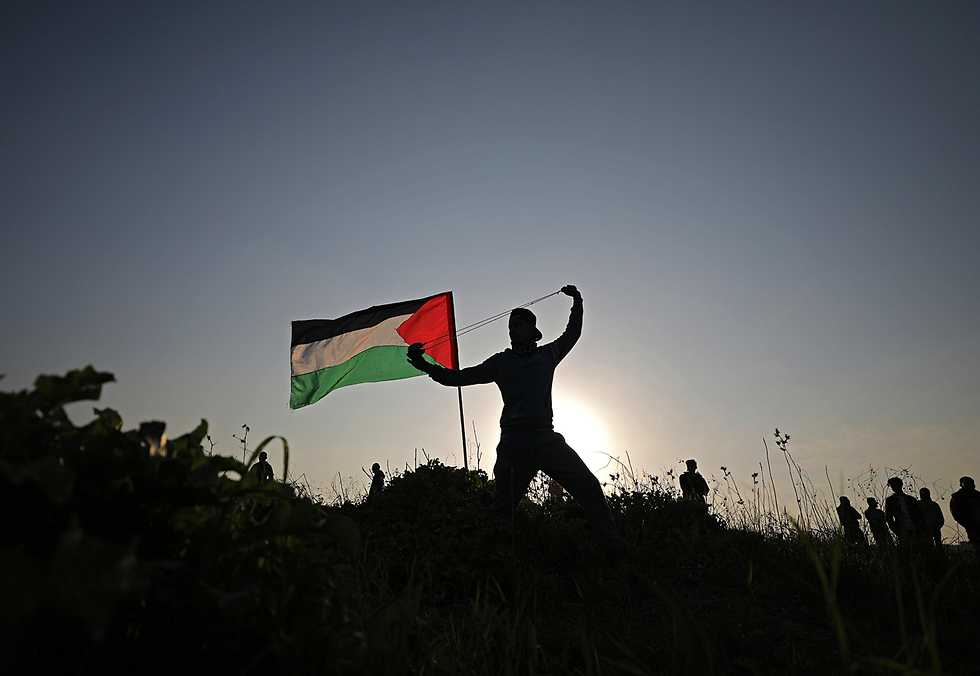
4 soldiers wounded near Gaza border as explosive device is set off
2 soldiers seriously wounded when approaching explosive device affixed to Palestinian flag near strip border; 2 others moderately wounded in gravest incident since Operation Protective Edge; IDF retaliates in Gaza against Hamas outposts, armament caches.
Two soldiers were seriously wounded and two others moderately and lightly wounded Saturday afternoon when an explosive device was set off near an IDF patrol around the border fence in the southern Gaza Strip, opposite the Ein HaShlosha kibbutz.
The IDF retaliated with tank fire at an observation post in the southern strip seemingly operated by Palestinian Islamic Jihad.
Emergency services flooded the scene and the wounded were airlifted to the Soroka University Medical Center in Be'er Sheva. Their families were notified.
Among those wounded are a Combat Engineering officer who was seriously wounded and a company commander from Golani's 13th Battalion who was lightly wounded.
Soroka's spokesman said, "After receiving initial treatment in the trauma room, the wounded were taken to operations." The hospital's deputy director added the soldiers' lives were not "immediately in danger."
Senior army officials visited the explosion's casualties and assessed the extent of their injuries as well as the treatment they were receiving. In addition, their families were called to the hospital and were kept abreast of their medical conditions.
Palestinian sources reported the Israeli Air Force attacked several targets in the Gaza Strip in retaliation, some of which were Hamas outposts. The attacks seemed to mostly target the outposts and rocket launch nooks and armament storages. No Palestinian Islamic jihad assets were targeted.
Despite not being targeted, Palestinian Islamic Jihad offered comment on the explosion, saying, "Gaza's guns are ready and the arms of its sons will spread rage against the siege and aggression. Gaza is neither a picnic nor an agricultural farm for Israel."
Hamas, for its part, said Israel will be held responsible for any escalation in the strip.
The explosive device was affixed to a Palestinian flag and appeared to have been placed near the fence under the cover of Friday's demonstrations nearby. Golani and Combat Engineering forces were inspecting several suspicions locations in the vicinity when the explosion occurred.
An initial inquiry into the incident found that trackers scoured the area, after which Combat Engineering soldiers approached the flag, under cover of the Golani soldiers, at which point the device was set off.
The IDF noted a growing trend of escalation in the protests organized by Hamas near the border fence, which have included use of weapons such as frag grenades. The demonstrations were "unacceptable manipulations," as per the army.
A situation assessment was held Saturday evening following the explosion with the participation of Chief of Staff Gadi Eisenkot, GOC Southern Command Maj.-Gen. Eyal Zamir, Air Force Commander Maj.-Gen. Amikam Norkin and other IDF top brass.
The IDF also intends to create an inquiry team to investigate the manner in which the force handled its examination of the suspicious flag, but initial estimates said they followed accepted protocol.
"We consider any point in which a flag, bag or rock is placed as a suspicious point," the army said, adding, "This is an extremely serious terror incident that may destabilize the region. The device, which included a pipe and was part of a flag, was placed on the Palestinian side of the fence with the explosion's main casualties coming from a Combat Engineering bomb removal squad, who had protection.
"The device belonged to rogue organizations and not Islamic Jihad. Hamas is responsible for the incident because it brought protesters to these 'spontaneous' demonstrations during the past few weeks, which are then utilized for terror."
IDF Spokesman Ronen Manelis added, "We are committed to calm and stability but remain ready for a variety of scenarios. We have channels of sending the message that Hamas remains responsible for anything that happens both above and below ground in the strip."
Prime Minister Benjamin Netanyahu, attending a security conference in Munich, said, "Today's incident on the Gaza Strip border is severe. We will respond appropriately. I send my wishes for a quick recovery to the wounded."
This marked the most serious such incident since the conclusion of Operative Protective Edge in 2014.
While the discovery or detonation of an explosive device near the Gaza border is unusual, it has taken place on several instances in the past since the end of Operation Protective Edge.
The last two times the IDF discovered explosive charges near the border took place about a year ago, in March 2017. In both instances either the devices or the people responsible for laying them were neutralized by IDF forces without Israeli casualties.
Relative calm had been maintained recently in the Israeli communities on the Gaza perimeter, on the backdrop of increasing Israeli warnings that he humanitarian situation in the isolated enclave is growing worse.
Two terror tunnels were discovered in the same region near the end of 2017, one excavated by Hamas and the other by Palestinian Islamic Jihad (PIJ).
The IDF detonated a PIJ terror tunnel running into Israeli territory this past October near the border with the strip. This past December, another tunnel was located, this time running several hundred meters into Israel. The tunnel, dug by Hamas, was also neutralized.
Several rockets were then fired from Gaza at Israel near the end of December, with one hitting a structure in the Sha'ar HaNegev Regional Council and two others intercepted midflight. The IDF retaliated by attacking several Hamas posts in the northern strip.
Several hours later, some 2,000 Palestinians demonstrated in nine different locations near the border. They threw rocks and attempted to comprise the fence, as per the IDF, and Israeli security forces returned fire at four of the disturbance's main instigators.
IDF Chief of Staff Gadi Eisenkot said at a weekly Cabinet meeting early February that no actors sought war or another round of hostilities in Gaza, but there was growing concern over a conflagration happening nonetheless due to the circumstances in the strip—the precarious humanitarian situation and the crisis in Hamas-Fatah relations.

The chief of staff added that efforts should be made to prevent a total humanitarian collapse in Gaza, but that humanitarian assistance—which the IDF supported—needed to be kept separate from a complete rehabilitation of Gaza, which should be conditioned on returning the bodies of IDF soldiers Oron Shaul and Hadar Goldin as well as the Israeli civilians held captive by Hamas.
